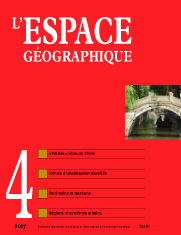

Thierry SANJUAN. Small towns in China. A renewed system between development and functional hierarchy
China as seen from below; the developmental stakes of small towns (5 fig.; 2 tabl.)
Since the 1980s, the uneven growth between China’s coasts and its inland has resulted in massive rural migrations. However, the migrants do not benefit from urban services linked to residency status. The recent project for a new form of urbanization and the loosening of the status of migrant in 2014 are both part of a policy to balance development throughout the territory. This new policy prioritizes the growth of small towns. They are encouraged to develop in order to slow the explosive growth of metropolitan areas. Their other function is to help create a network of development poles at the local and regional levels and thus integrate rural areas. This orientation in the recent history of urbanization leads to two questions. The first is the issue of regional planning blueprints that take into account the network of infrastructures. The second addresses the capacities and the modalities of public and private investments that are vital to the ‘‘harmonious’’ development of the territory. For existing cities, this policy directly affects debate on the elaboration of more flexible over-arching projects that can adapt to economic evolutions that take into consideration the local heritage, the creation and requalification of public equipment and housing. This leads us to explore the relative independence of existing small town in the organization and evolution of their own development in terms of regional metropolitan areas within a new context of inter- and intra-provincial competition.
keywords: CHINA, DEVELOPMENT, MIGRATION, URBAN FRAMEWORK, URBAN HIERARCHY, URBANISM
Small cities at the heart of the composition of Chinese territories. The case of Zhejiang province (6 fig.; 2 photos; 6 tabl.)
This article focuses on the evolution of the urban framework since the early 1980s in the province of Zhejiang in China. Zhejiang province, whose urbanization rate increased from 14 to 62% between 1980 and 2010 – compared to the national average of 50% – is located south of Shanghai. The development of small cities is proving to be the driving force behind the province’s urban framework. In 1990, the province had only 13 small cities. There were 45 in 2000 and 52 in 2010. Focusing on these urban entities, our research analyses their evolution in the urban system and their relations with their rural peripheries that have been substantially modified, leading to a redistribution of activities and populations in a mixed functional space.
keywords: CHINA, URBAN FRAMEWORK, URBAN PLANNING, ZHEJIANG PROVINCE, SMALL TOWN
In the shadow of Shanghai: A new small town, relay of urbanisation and metropolitan urbanity (5 fig.; 3 tabl.)
This contribution on small towns and cities underlines the relaying and supporting role of rapid urbanization in the 2000s, through the example of a small, new town. We demonstrate how the new town of Songjiang, on the outskirts of Shanghai, structures the polycentric networking organization of the Shanghai metropolis, through the development of a well-planned urban project designed to accommodate median incomes. Through the accumulation of geographically and socially different populations, this small, new town participates in the socio-spatial restructuring of the megalopolis’s periphery, in order to function as a melting pot, encouraging the development of a Chinese – and not a local – metropolitan urbanity.
keywords: CHINA, NEW TOWN, RELAY TOWN, URBANISATION, URBANITY, URBAN PROJECT
Cultural heritage as tourist draw: The ancient town of Tongli in Jiangsu province (3 fig.; 5 photos)
After initiating a conclusive heritage policy in the early 1980s, the small city of Tongli became, along with Zhouzhuang (Jiangsu), a widely copied model for heritage preservation and the development of tourism. However, this model, the product of top-down decision-making, is currently facing its first challenges. This article situates the heritage transformation of Tongli and other small cities in a local and national context in order to better understand the issues and actors involved, along with China's unique conceptualizations of heritage and tourism in China.
keywords: CHINA, HERITAGE, LOCAL GOUVERNMENT, TOURISM
Enhancing the heritage value of small cities in the Western region of Sichuan province: The dynamics of development in Dujiangyan and Qingchengshan (4 fig.; 12 photos; 2 tabl.)
In 2000, “Mount Qingcheng and the Dujiangyan irrigation system” were added to UNESCO’s World Heritage Sites. This led to an acceleration of urban and tourist development projects in Dujiangyan and Qingchengshan such as projects for new buildings and the construction of a infrastructures tied to the boom in tourism. This article examines the role of Chinese towns, like Dujiangyan, that administer a predominantly rural county, in the context of the economic and touristic development of Sichuan province. Various levels of the Chinese State have invested heavily to enhance the heritage and tourist facets of Dujiangyan and Qingchengshan’s economy. Their efforts illustrate the urban, economic and political stakes of towns in China’s hinterlands and in so doing, illustrate the reality of development within the municipality’s territory.
keywords: CENTER-PERIPHERY, CHINE, DEVELOPMENT, HERITAGE, TOURISM, URBANISATION
Book reviews
In this issue of l’Espace géographique, you will find critical reviews of the following books
LUCCHINI F. (dir.)(2016). La Mise en culture des friches industrielles. Rouen: Presses universitaires de Rouen et du Havre, 306 p. (Yves Guermond, université de Rouen, UMR IDEES) ISBN: 979-10-240-0460-0
L’espace géographique 3/17![]()
![]() L’espace géographique 1/18
L’espace géographique 1/18
For subscribe or buy this issue: BELIN
![]() L’Espace géographique: contents
L’Espace géographique: contents
Last modified: December 11, 2017